If there were a temple dedicated to Indian cuisine, Suvir Saran would be its chief priest and most ardent devotee. The 35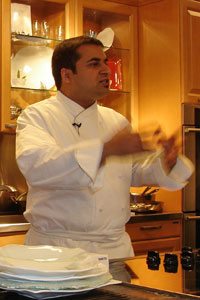 -year-old New York based chef, cookbook writer and teacher says quite simply, “India will inspire me for as many lives as I live. It has a million muses for me and I am not even past one yet.”
-year-old New York based chef, cookbook writer and teacher says quite simply, “India will inspire me for as many lives as I live. It has a million muses for me and I am not even past one yet.”
Saran has been passionate about cooking since he was six years old but it is only in the past decade that he has brought the intricate ragas of real Indian food to everyone who would listen and has developed quite a fan following.
He’s cooked for Brooke Astor, the late doyenne of American high society, as well as for a dinner hosted for Al Gore, and another in honor of actress Jean Moreau. The model Kristy Hume has taken cooking lessons from him, and New York magazine listed him amongst the top caterers in New York City, featuring his orange mango soufflé with candied mango peel and fresh pomegranate seeds on the cover.
Celebrities including the rock group U2 and actress Uma Thurman have frequented the critically acclaimed restaurant Devi, where Saran is co-executive chef and co-owner with Hemant Mathur, the tandoor master. Dévi received a Michelin one-star rating in 2007 and 2008, as well as a three-star rating from New York Magazine and two stars from The New York Times.
Saran’s first cookbook ‘Indian Home Cooking: A Fresh Introduction to Indian Food’, was written with food writer Stephanie Lyness, It received great reviews but what particularly thrilled Saran was the fact that he received so many emails from young Indians who have cooked from it and have found themselves transported to the foods they grew up eating in Indian homes.
Yes, Saran is on a mission to showcase the ‘real’ Indian food to America, the wonderful comfort foods and family treats we eat at home.
So he’s been talking – and America has been listening. His cooking classes at New York University have been listed amongst the most popular in the city by New York magazine and his quotes and recipes have appeared in every major magazine from The New York Times to The Los Angeles Times. As a caterer, he has created theme parties revolving around spices, exotic dishes and Indian music, and his clients have included Asia Society and Carnegie Hall.
 What is really surprising to most people is the fact that Saran, who has taught classes across the country, including at the Culinary Institute and NYU – has never, ever received any formal training or attended classes himself! In fact, he started out as a graphic designer and studied at the School of Visual Arts in New York, before working in merchandising.
What is really surprising to most people is the fact that Saran, who has taught classes across the country, including at the Culinary Institute and NYU – has never, ever received any formal training or attended classes himself! In fact, he started out as a graphic designer and studied at the School of Visual Arts in New York, before working in merchandising.
So where did the cooking magic happen? Back in the kitchens of his childhood, in homes in Delhi, Nagpur, Bombay. While other boys would be out playing cricket, Saran would be in the kitchen with the Brahmin cook, Panditji as Dadi, his imperious grandma, gave directions from her seat outside the kitchen.
“Food in some ways became my anchor,” recalls Saran. “And our home truly was the Grand Central Station of New Delhi. A revolving door and an endless dinner party. My Dadi, mom and Panditji, were legends around food and each of them was famous for dishes no one could match. My mother the expert baker, and Dadi, through Panditji, who she had trained, shared amazing savories, unlike any you could find, even dishes that one hardly ever finds in homes. Many of which, like the Kathal Biryani and the Karelas have made it to the menu at Devi.”
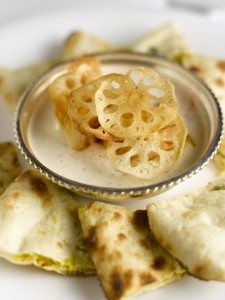 His maternal grandmother, Nani, who lived in San Francisco, was also a talented cook who inspired him to adapt traditional dishes to suit the time constraints of modern life. “I have never taken cooking classes so I find it amusing that I have ended up teaching in professional culinary schools and institutes,” says Saran. “Actually, I find myself equipped with the best training, the training from mothers, home chefs and elders. The best education one could ever hope for, but can never buy.”
His maternal grandmother, Nani, who lived in San Francisco, was also a talented cook who inspired him to adapt traditional dishes to suit the time constraints of modern life. “I have never taken cooking classes so I find it amusing that I have ended up teaching in professional culinary schools and institutes,” says Saran. “Actually, I find myself equipped with the best training, the training from mothers, home chefs and elders. The best education one could ever hope for, but can never buy.”
When he first came to New York he was struck by the lackluster Indian restaurants and craved for real home cooked food. “I missed the simple ghar ka khana that celebrates the genius of Indian cuisine,” he recalled of the days he was working as a buyer at Bergdorf Goodman and then as a retail director at Henri Bendel. “Through all of these work environs, the only thing that remained constant was my cooking dinner for my family of friends and relatives and neighbors and co-workers.”
The word got out about Saran’s wonderful home cooking and before he knew it, one thing led to another and the catering and teaching followed. He says, “All of this happened on the side, but was the thing that really made me tick and live for. And soon, years after having lived dual lives, I found myself fully immersed in the world of food.”
At Devi, he and his long time friend Hemant Mathur have found the perfect canvas for their food creations. “ Hemant and I have worked together for close to 11 years. We are the ying and yang of the kitchen,” says Saran. He points out that their food is not the usual curry house predictable stuff, nor frivolous fusion: “It is just what it should be, simple food from the homes of India, from its restaurants and streets, from its many regions and communities, but shared with a flair that comes from a certain confidence life gives you when you have traveled.”
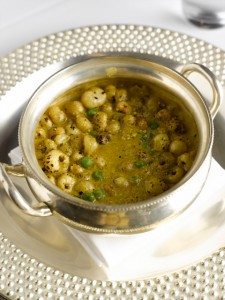 While you won’t find the stereotypical restaurant dishes like vindaloo or korma on the menu, you will find home specialties like Karelas (bitter melon), Parwal, Tindas, Kamal Kakree (lotus stem), phool makhanas (lotus seeds), kathal (jackfruit), zimikand (yam) and arbi (colocasia).
While you won’t find the stereotypical restaurant dishes like vindaloo or korma on the menu, you will find home specialties like Karelas (bitter melon), Parwal, Tindas, Kamal Kakree (lotus stem), phool makhanas (lotus seeds), kathal (jackfruit), zimikand (yam) and arbi (colocasia).
“I want dishes on the menu that Indians have forgotten or do not often cook at home,” he says. “You will not believe how many Indians who are visiting the US from India ask to speak with us, and then go on to explain how many of the dishes they eat at Devi, have been lost to India as well.”
Saran lives with his partner Charlie Burd downtown in the Financial District in an apartment on the 22nd floor of one of the first high rise buildings ever built, which was earlier known as the Pulitzer Building. From there, he has a commanding presence of the wonderful city called New York. Says Saran, “New York is not Bombay or even Delhi, but if I were to live anywhere other than those two amazing Indian cities, this is one fine city.”
The two have also embarked on an upstate adventure with their 68 acre American Masala farm where they grow produce, tend to livestock and live like sons of the soil.
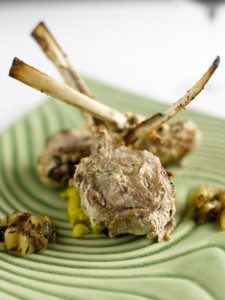 Also part of the family are their cats Simba and Kali and dog Sebastian, who is a foodie like his master. “Sebastian got familiar with Indian cuisine at the age of 5, but at age 7, there is nothing prepared in this home or Devi that he has not eaten and enjoyed,” he says. “Even whole red and green chilies and mango pickle have become his favorites. Maybe Sebastian is one of my own past or future lives. Who knows?”
Also part of the family are their cats Simba and Kali and dog Sebastian, who is a foodie like his master. “Sebastian got familiar with Indian cuisine at the age of 5, but at age 7, there is nothing prepared in this home or Devi that he has not eaten and enjoyed,” he says. “Even whole red and green chilies and mango pickle have become his favorites. Maybe Sebastian is one of my own past or future lives. Who knows?”
Saran seems to have traveled all over the food map: He is Chairman, Asian Culinary Studies, World Cuisines Council for The Culinary Institute of America. In 2006, he was hired by Sodexo, Inc. as an international concept and brand development partner. He’s also got another cookbook out, ‘American Masala: 125 New Classics From My Home Kitchen’ with Raquel Pelzel, which merges east and west in innovative recipes.
This food maestro can whip up exotic dishes like Lucknowi chaat, Murgh Khubani and Zafrani Pullao without blinking an eye. So what does he himself hunger for? ”When missing India, or when tired from travels and a long week, simple dal, chawal and some raita is magic to me,” he says. “It is soul food and all the nourishment I need at such times.”
Ask him if he’s a natural cook and he says, “I think cooking comes naturally to all of us. Some of us allow it to come out; others find ways of creating a mental block that keeps it from coming out. Mistakes teach us and mistakes and accidents often result in the most surprising and haunting of all creations. If it were not for accidents, I would not be cooking today.”
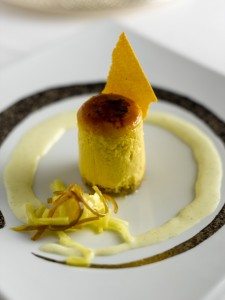 And the one ingredient a cook must always have on hand? Says Suvir Saran: “Hope.” He encourages his students to let go of the rules and expectations and be inventive. Indulge the senses and the recipe will fall into their lap: “When the tomato is unripe, fry it and bring out its juices from the innermost ripe center. When the tomato is very ripe and almost ready to rot, use its overt juices to cook slowly and with love to create a jam or chutney that shall stand testament to the magic of perfect ripeness.”
And the one ingredient a cook must always have on hand? Says Suvir Saran: “Hope.” He encourages his students to let go of the rules and expectations and be inventive. Indulge the senses and the recipe will fall into their lap: “When the tomato is unripe, fry it and bring out its juices from the innermost ripe center. When the tomato is very ripe and almost ready to rot, use its overt juices to cook slowly and with love to create a jam or chutney that shall stand testament to the magic of perfect ripeness.”
Life, like food, is what you make of the ingredients….
© Lavina Melwani
Photos: Suvir Saran by Kathryn Noble; Devi and food images by Ben Fink

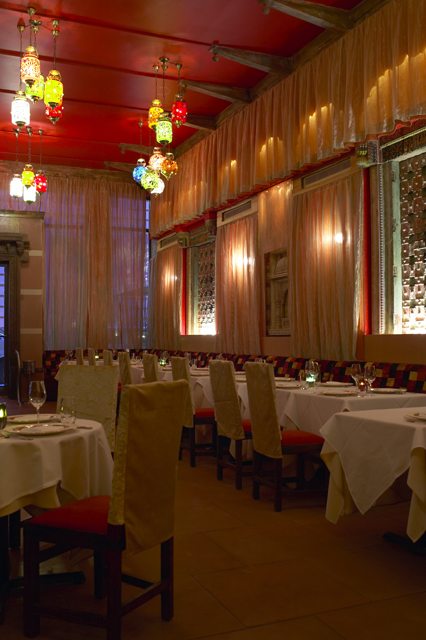
1 Comment
Please send recipe of kamal kakree stem of lotus from Suvir
Thanks